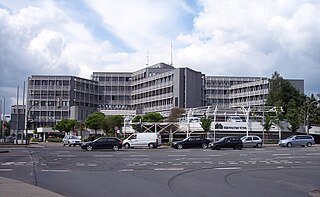
This list of the mountains and hills in North Rhine-Westphalia shows a selection of high or well-known mountains and hills in the German state of North Rhine-Westphalia (in order of height).

This list of the mountains and hills in North Rhine-Westphalia shows a selection of high or well-known mountains and hills in the German state of North Rhine-Westphalia (in order of height).
The following table gives the highest hill or point in the five provinces (Regierungsbezirke) of North Rhine-Westphalia.
By clicking on the word "List" in the "Lists" column you will be taken to a list of other hills in the respective region or hill range (some of which lie partly outside of North Rhine-Westphalia). The table is listed in order of height, but can be sorted by other columns by clicking on the symbol at the head.
| Highest summit | Height (m) | Region/range | Lists | Province |
|---|---|---|---|---|
| Langenberg | 843.2 | Rothaar | List | Arnsberg |
| Weißer Stein | 693 | Eifel (Zitterwald) | List | Cologne |
| Köterberg | 495.8 | Weser Uplands | List | Detmold* |
| Brodtberg | 378.9 | Bergisches Land | --- | Düsseldorf |
| Westerbecker Berg | 236 | Teutoburg Forest | List | Münster |

In the following table are the highest mountains and hills in the various North Rhine-Westphalian landscapes (regions or hill ranges).
In the "Landscape" column, major hill ranges are shown in bold and landscape units that have no significant local high point or are basins, whose (sometimes island-like) high points have some isolation, are shown in italics. Clicking "List" in the rows of the "List" column links to other hills or mountains in that landscape – some of which are outside of North Rhine-Westphalia. The table is arranged by height, but may be sorted by other criteria by clicking the symbol of the desired column.








Name, Height in metres above NN, Location (district/landscape); three "???" means unknown or not researched; please complete!


Westphalia is a region of northwestern Germany and one of the three historic parts of the state of North Rhine-Westphalia. It has an area of 20,210 square kilometres (7,800 sq mi) and 7.9 million inhabitants.

The Märkischer Kreis is a district (Kreis) in central North Rhine-Westphalia, Germany. Neighbouring districts are Unna, Soest, Hochsauerland, Olpe, Oberbergischer Kreis, Ennepe-Ruhr, and the city of Hagen.
Hochsauerlandkreis is a Kreis (district) in the east of North Rhine-Westphalia, Germany. Neighboring districts are Soest, Paderborn, Höxter, Waldeck-Frankenberg, Siegen-Wittgenstein, Olpe, Märkischer Kreis.
Olpe is a Kreis (district) in the south-east of North Rhine-Westphalia, Germany. Neighboring districts are Märkischer Kreis, Hochsauerland, Siegen-Wittgenstein, Altenkirchen, Oberbergischer Kreis.
Siegen-Wittgenstein is a Kreis (district) in the southeast of North Rhine-Westphalia, Germany. Neighboring districts are Olpe, Hochsauerlandkreis, Waldeck-Frankenberg, Marburg-Biedenkopf, Lahn-Dill, Westerwaldkreis, and Altenkirchen.
Soest is a Kreis (district) in the middle of North Rhine-Westphalia, Germany. Neighbouring districts are Warendorf, Gütersloh, Paderborn, Hochsauerland, Märkischer Kreis, Unna and the independent town of Hamm.

Arnsberg is one of the five Regierungsbezirke of North Rhine-Westphalia, Germany, located in the west-central part of the country. It covers the Sauerland hills as well as the east part of the Ruhr area.

The Sauerland is a rural, hilly area spreading across most of the south-eastern part of North Rhine-Westphalia, in parts heavily forested and, apart from the major valleys, sparsely inhabited.

Lennestadt lies in the Sauerland in southeast North Rhine-Westphalia and is a community in Olpe district. It is the district's most populous municipality. Lennestadt itself is not an actual town but a community which comprises several towns and villages.

Olpe is a town situated in the foothills of the Ebbegebirge in North Rhine-Westphalia, roughly 60 km east of Cologne and 20 km northwest of Siegen. It is part of the Regierungsbezirk of Arnsberg and is the seat of the district of Olpe.

Kirchhundem is a German community in North Rhine-Westphalia. It belongs to the Olpe district.

The Duchy of Westphalia was a historic territory in the Holy Roman Empire, which existed from 1102 to 1803. It was located in the greater region of Westphalia, originally one of the three main regions in the German stem duchy of Saxony and today part of the state of North Rhine-Westphalia. The duchy was held by the archbishop-electors of Cologne until its secularization in 1803.

The Rothaar Mountains, or Rothaar, is a low mountain range reaching heights of up to 843.1 m in North Rhine-Westphalia and Hesse, Germany.

The Saalhausen Hills are a range of hills up to 687.7 m above sea level (NN) high in the Sauerland region within the districts of Olpe and Hochsauerlandkreis in the German state of North Rhine-Westphalia. They are part of the Rhine Massif and lie within the Süder Uplands.

The Arnsberg Forest Nature Park is a nature park in the districts of Hochsauerlandkreis and Soest within the administrative region of Arnsberg in the German state of North Rhine-Westphalia. The park was established in 1960 and covers an area of 482 km². Nearly 350 km² of the protection is forested and the park's wooded hills rise up to 581.5 m above sea level (NN).

The Upland is a low mountain region forming the northeastern part of the High Sauerland and belongs the German state of Hesse, unlike the remainder of the High Sauerland which lies in Westphalia. The Upland falls within the district of Waldeck-Frankenberg, in North Hesse and corresponds to the territory of the municipality of Willingen.

The Plackwald is a ridge of hills, up to 581.5 m above sea level (NHN), and part of the Rhenish Massif in the counties of Soest and Hochsauerlandkreis, North Rhine-Westphalia, Germany. Within the North Sauerland Highlands it forms the natural region sub-unit of Plackweghöhe (Plackwald) (334.5).

Siegerland-Höhenring(Siegerland mountain ridge circular route) is an approximately 142-kilometre-long (88-mile-long) hiking trail in Germany that circles most parts of Siegerland in the districts of Siegen-Wittgenstein and Altenkirchen.